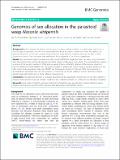Files in this item
Genomics of sex allocation in the parasitoid wasp Nasonia vitripennis
Item metadata
| dc.contributor.author | Pannebakker, Bart A. | |
| dc.contributor.author | Cook, Nicola | |
| dc.contributor.author | van den Heuvel, Joost | |
| dc.contributor.author | van de Zande, Louis | |
| dc.contributor.author | Shuker, David M. | |
| dc.date.accessioned | 2020-07-24T14:30:03Z | |
| dc.date.available | 2020-07-24T14:30:03Z | |
| dc.date.issued | 2020-07-20 | |
| dc.identifier | 269273639 | |
| dc.identifier | e35b1dc6-7fed-4a71-9ed6-47f115337498 | |
| dc.identifier | 000553452100005 | |
| dc.identifier | 85088351906 | |
| dc.identifier.citation | Pannebakker , B A , Cook , N , van den Heuvel , J , van de Zande , L & Shuker , D M 2020 , ' Genomics of sex allocation in the parasitoid wasp Nasonia vitripennis ' , BMC Genomics , vol. 21 , 499 . https://doi.org/10.1186/s12864-020-06904-4 | en |
| dc.identifier.issn | 1471-2164 | |
| dc.identifier.other | RIS: urn:5CA3E9E82EB283E0376B65CA0F317852 | |
| dc.identifier.other | RIS: Pannebakker2020 | |
| dc.identifier.other | ORCID: /0000-0003-4462-0116/work/77893742 | |
| dc.identifier.uri | https://hdl.handle.net/10023/20330 | |
| dc.description | This research was funded by the Netherlands Genomics Initiative (Zenith 93511041) and the by the Natural Environment Research Council (NE/J024481/1). | en |
| dc.description.abstract | Background Whilst adaptive facultative sex allocation has been widely studied at the phenotypic level across a broad range of organisms, we still know remarkably little about its genetic architecture. Here, we explore the genome-wide basis of sex ratio variation in the parasitoid wasp Nasonia vitripennis, perhaps the best studied organism in terms of sex allocation, and well known for its response to local mate competition. Results We performed a genome-wide association study (GWAS) for single foundress sex ratios using iso-female lines derived from the recently developed outbred N. vitripennis laboratory strain HVRx. The iso-female lines capture a sample of the genetic variation in HVRx and we present them as the first iteration of the Nasonia vitripennis Genome Reference Panel (NVGRP 1.0). This panel provides an assessment of the standing genetic variation for sex ratio in the study population. Using the NVGRP, we discovered a cluster of 18 linked SNPs, encompassing 9 annotated loci associated with sex ratio variation. Furthermore, we found evidence that sex ratio has a shared genetic basis with clutch size on three different chromosomes. Conclusions Our approach provides a thorough description of the quantitative genetic basis of sex ratio variation in Nasonia at the genome level and reveals a number of inter-related candidate loci underlying sex allocation regulation. | |
| dc.format.extent | 14 | |
| dc.format.extent | 5649895 | |
| dc.language.iso | eng | |
| dc.relation.ispartof | BMC Genomics | en |
| dc.subject | Local mate competition | en |
| dc.subject | Nasonia | en |
| dc.subject | Oviposition | en |
| dc.subject | Parasitoid wasp | en |
| dc.subject | Sex allocation | en |
| dc.subject | Genetic reference panel | en |
| dc.subject | Single nucleotide polymorphism (SNP) | en |
| dc.subject | Genome-wide association study (GWAS) | en |
| dc.subject | QH426 Genetics | en |
| dc.subject | DAS | en |
| dc.subject.lcc | QH426 | en |
| dc.title | Genomics of sex allocation in the parasitoid wasp Nasonia vitripennis | en |
| dc.type | Journal article | en |
| dc.contributor.sponsor | NERC | en |
| dc.contributor.institution | University of St Andrews.School of Biology | en |
| dc.contributor.institution | University of St Andrews.Centre for Biological Diversity | en |
| dc.contributor.institution | University of St Andrews.Scottish Oceans Institute | en |
| dc.contributor.institution | University of St Andrews.Institute of Behavioural and Neural Sciences | en |
| dc.identifier.doi | 10.1186/s12864-020-06904-4 | |
| dc.description.status | Peer reviewed | en |
| dc.identifier.grantnumber | NE/J024481/1 | en |
This item appears in the following Collection(s)
Items in the St Andrews Research Repository are protected by copyright, with all rights reserved, unless otherwise indicated.

